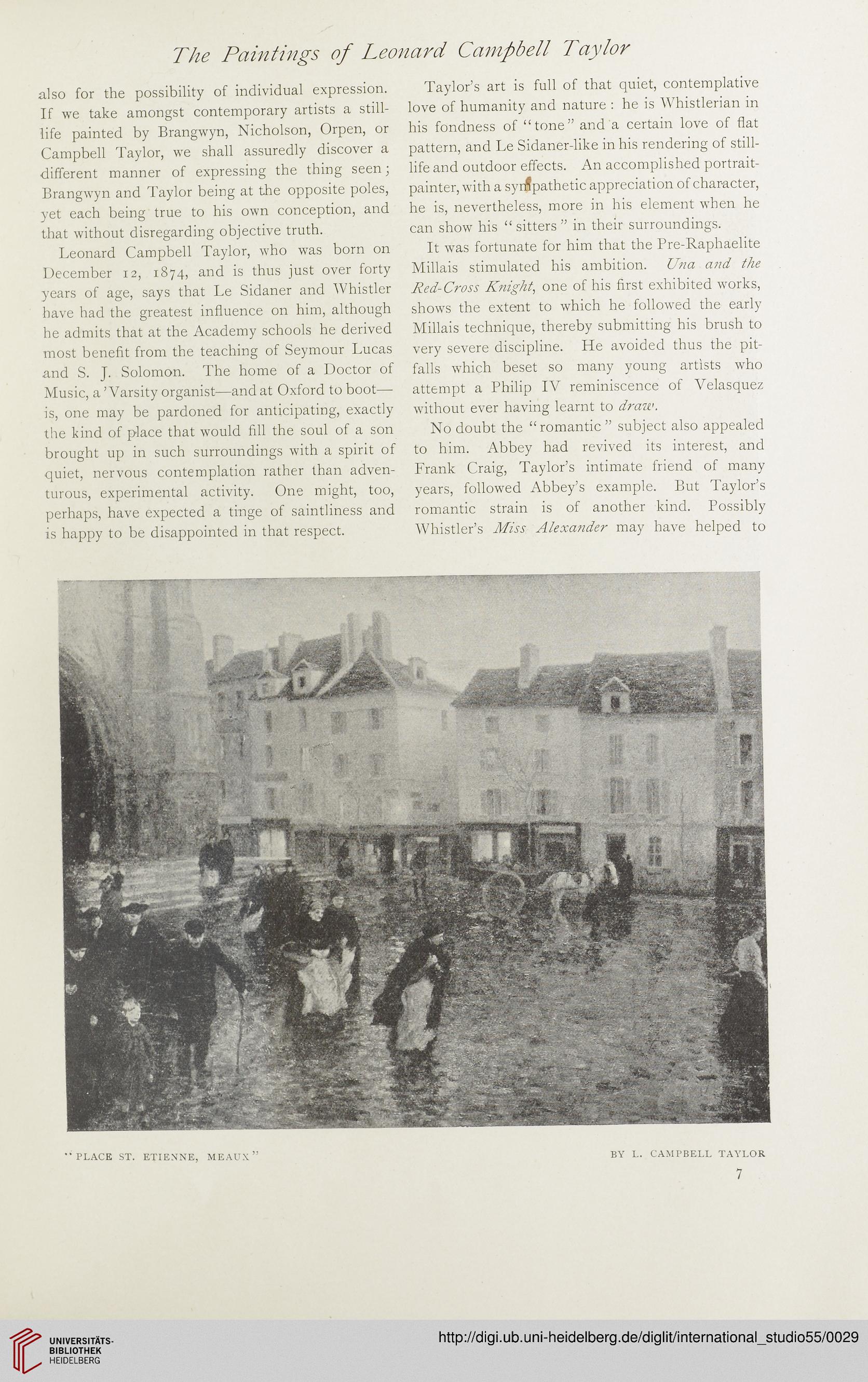The Paintings of Leonard Campbell Taylor
also for the possibility of individual expression.
If we take amongst contemporary artists a still-
life painted by Brangwyn, Nicholson, Orpen, or
Campbell Taylor, we shall assuredly discover a
different manner of expressing the thing seen;
Brangwyn and Taylor being at the opposite poles,
yet each being true to his own conception, and
that without disregarding objective truth.
Leonard Campbell Taylor, who was born on
December 12, 1874, and is thus just over forty
years of age, says that Le Sidaner and Whistler
have had the greatest influence on him, although
he admits that at the Academy schools he derived
most benefit from the teaching of Seymour Lucas
and S. J. Solomon. The home of a Doctor of
Music, a ’Varsity organist—and at Oxford to boot—
is, one may be pardoned for anticipating, exactly
the kind of place that would fill the soul of a son
brought up in such surroundings with a spirit of
quiet, nervous contemplation rather than adven-
turous, experimental activity. One might, too,
perhaps, have expected a tinge of saintliness and
is happy to be disappointed in that respect.
Taylor’s art is full of that quiet, contemplative
love of humanity and nature : he is Whistlerian in
his fondness of “tone” and a certain love of flat
pattern, and Le Sidaner-like in his rendering of still-
life and outdoor effects. An accomplished portrait-
painter, with a sympathetic appreciation of character,
he is, nevertheless, more in his element when he
can show his “ sitters ” in their surroundings.
It was fortunate for him that the Pre-Raphaelite
Millais stimulated his ambition. Una and the
Red-Cross Knight, one of his first exhibited works,
shows the extent to which he followed the early
Millais technique, thereby submitting his brush to
very severe discipline. He avoided thus the pit-
falls which beset so many young artists who
attempt a Philip IV reminiscence of Velasquez
without ever having learnt to draw.
No doubt the “romantic” subject also appealed
to him. Abbey had revived its interest, and
Frank Craig, Taylor’s intimate friend of many
years, followed Abbey’s example. But Taylor’s
romantic strain is of another kind. Possibly
Whistler’s Miss Alexander may have helped to
"PLACE ST. ETIENNE, MEAUX”
BY L. CAMPBELL TAYLOR
7
also for the possibility of individual expression.
If we take amongst contemporary artists a still-
life painted by Brangwyn, Nicholson, Orpen, or
Campbell Taylor, we shall assuredly discover a
different manner of expressing the thing seen;
Brangwyn and Taylor being at the opposite poles,
yet each being true to his own conception, and
that without disregarding objective truth.
Leonard Campbell Taylor, who was born on
December 12, 1874, and is thus just over forty
years of age, says that Le Sidaner and Whistler
have had the greatest influence on him, although
he admits that at the Academy schools he derived
most benefit from the teaching of Seymour Lucas
and S. J. Solomon. The home of a Doctor of
Music, a ’Varsity organist—and at Oxford to boot—
is, one may be pardoned for anticipating, exactly
the kind of place that would fill the soul of a son
brought up in such surroundings with a spirit of
quiet, nervous contemplation rather than adven-
turous, experimental activity. One might, too,
perhaps, have expected a tinge of saintliness and
is happy to be disappointed in that respect.
Taylor’s art is full of that quiet, contemplative
love of humanity and nature : he is Whistlerian in
his fondness of “tone” and a certain love of flat
pattern, and Le Sidaner-like in his rendering of still-
life and outdoor effects. An accomplished portrait-
painter, with a sympathetic appreciation of character,
he is, nevertheless, more in his element when he
can show his “ sitters ” in their surroundings.
It was fortunate for him that the Pre-Raphaelite
Millais stimulated his ambition. Una and the
Red-Cross Knight, one of his first exhibited works,
shows the extent to which he followed the early
Millais technique, thereby submitting his brush to
very severe discipline. He avoided thus the pit-
falls which beset so many young artists who
attempt a Philip IV reminiscence of Velasquez
without ever having learnt to draw.
No doubt the “romantic” subject also appealed
to him. Abbey had revived its interest, and
Frank Craig, Taylor’s intimate friend of many
years, followed Abbey’s example. But Taylor’s
romantic strain is of another kind. Possibly
Whistler’s Miss Alexander may have helped to
"PLACE ST. ETIENNE, MEAUX”
BY L. CAMPBELL TAYLOR
7




